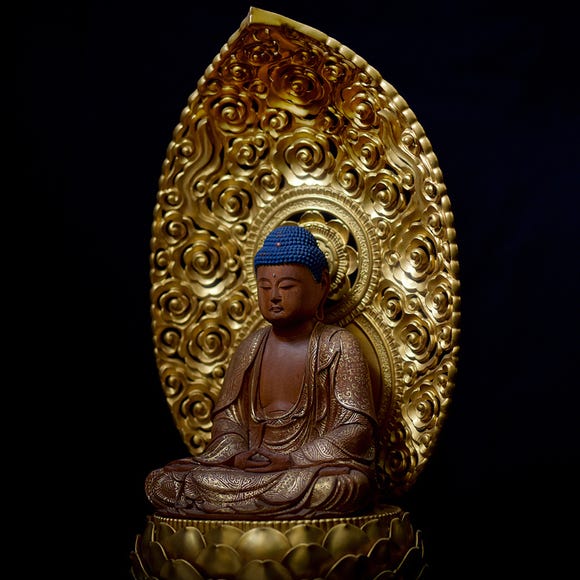The town of Maruyama, in Yamagata Prefecture, bills itself as the birthplace of iaido. A martial art that focuses on drawing a sword from its scabbard and striking in one smooth, swift motion, iaido is said to have been developed by the 16th century swordsman Hayashizaki Jinsuke Shigenobu, who hailed from the area and is enshrined at the town’s Kumano Iaii Shrine.
Seeking a way to share this aspect of its culture with visitors, in 2017 the Murayama Tourism Association came up with the idea of offering lessons in which travelers would learn the history and fundamentals of iaido, culminating with a test of their skills in which they would wield an actual sharpened katana and attempt to slice through a tatami reed practice target, a training activity known as tameshigiri, or “practice cutting.”
It’s a unique and dynamic way to experience traditional Japanese culture first-hand, and the program quickly proved to be a big hit, especially among foreign travelers visiting Japan. The Murayama program even received an award for excellence in Sports and Culture Tourism from the Japanese government in 2020.
Following Murayama’s success, a number of other places in Japan with samurai heritages of their own started similar tourism programs with tameshigiri as the highlight event.
When Murayama was first considering including tameshigiri as part of its iaido lessons for tourists, they ran the idea by the Yamagata Prefectural Police, who said that it wouldn’t be a problem as long as it was sufficiently supervised. Prefectural authorities in other parts of Japan with tameshigiri-inclusive lessons apparently felt likewise. But last December, Japan’s National Police Agency informed the country’s prefectural police forces that it finds such programs to be in violation of Japan’s Firearm and Sword Control Law, on the grounds that “Letting groups such as unspecified numbers of tourists use registered [sharpened] swords for temporary entertainment purposes is fundamentally not allowed.”
Murayama has since pivoted to tameshigiri demonstrations, in which the iado lesson instructors are the ones doing the cutting with sharpened blades, but the head of the city tourism association laments that something that had been a major draw had to be eliminated. A martial arts instructor in Akita Prefecture, whose dojo also previously offered lessons for travelers that included tameshigri, similarly says that without it the lessons are receiving fewer reservations.
Despite swords being a popular symbol of the Japan’s historical culture, they’re strictly regulated in modern society (this is, after all, the country where you could be arrested for having a certain officially licensed piece of Harry Potter merch). Thankfully, Murayama’s iaido lessons are still being offered, though without tameshigiri, and hopefully they’ll be able to capture enough interest to help preserve the tradition in a vibrant, participatory way, so that it doesn’t become a mere relic of the past.
Related: Murayama Iaido Experience official website
Source: Yomiuri Shimbun, Murayama Iaido Experience official website
Top image: Pakutaso
*Prices and options mentioned are subject to change.
*Unless stated otherwise, all prices include tax.
Recommended places for you
-

Jukuseiniku-to Namamottsuarera Nikubaru Italian Nikutaria Sannomiya
Izakaya
Kobe, Sannomiya, Kitano
-

ISHIDAYA Hanare
Yakiniku
Kobe, Sannomiya, Kitano
-
Appealing

Rukku and Uohei
Izakaya
Sapporo / Chitose
-
Goods

Yoshida Gennojo-Roho Kyoto Buddhist Altars
Gift Shops
Nijo Castle, Kyoto Imperial Palace
-

Kambei Sannomiyahonten
Yakiniku
Kobe, Sannomiya, Kitano
-

Kanzenkoshitsuyakinikutabehodai Gyugyu Paradise Sannomiya
Yakiniku
Kobe, Sannomiya, Kitano
-

Fewer Japanese people traveling domestically, government blames birth rate, others blame foreign crowds, costs
-

Discover Japan Duty Free GINZA: A Unique Shopping Experience in the Heart of Tokyo
by: Chehui Peh
-

Tokyo travel hack: How to enjoy a free sightseeing boat tour around Tokyo Bay
-

With arrests of foreigners in Japan increasing, police no longer guarantee in-person translators
-

Family Mart is giving away free socks for your ice cream in Japan
-

Old soba restaurant on Japanese train station platform serves noodles with a side of nostalgia
-

3-Day Kyoto Itinerary: Spring Travel Guide for First-Time Visitors
by: Cassandra Ling
-
Ad

Healthy Alternative: Japanese ‘Rice Meister’ Pros Share 8 Recipes & Pairing Secrets!
-

10 Important Japanese Phrases to Know Before You Enter a Japanese Convenience Store!
by: Teni Wada
-

Kabuki in Tokyo: See Authentic Japanese Kabuki at Kabukiza Theater in Ginza
-

10 Best Hotels Near Sendai Station: Picks Under $100
-

10 Best Hotels Near Kyoto Station: Budget-friendly, Perfect for Kyoto Sightseeing
- #best sushi japan
- #what to do in odaiba
- #what to bring to japan
- #new years in tokyo
- #best ramen japan
- #what to buy in ameyoko
- #japanese nail trends
- #things to do japan
- #onsen tattoo friendly tokyo
- #daiso
- #best coffee japan
- #best japanese soft drinks
- #best yakiniku japan
- #japanese fashion culture
- #japanese convenience store snacks















